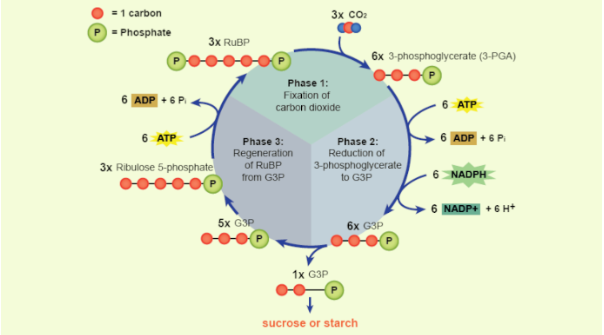Table of Contents
Photosynthesis, the process by which plants and other organisms convert light energy into chemical energy, is a cornerstone of life on Earth. At the heart of this intricate process lies the Calvin Cycle, also known as the Calvin-Benson Cycle or the C3 cycle. Named after the American scientist Melvin Calvin, who played a key role in its discovery, the Calvin Cycle is responsible for the production of glucose and other essential organic compounds. This article delves into the intricacies of the Calvin Cycle, exploring its definition, stages, and products.
Definition of Calvin Cycle
The Calvin Cycle is a series of biochemical reactions that occur in the stroma of chloroplasts during the light-independent reactions of photosynthesis. It is a vital part of the dark reactions, also called the light-independent reactions or the carbon fixation phase, which occur after the light-dependent reactions. In essence, the Calvin Cycle captures carbon dioxide from the atmosphere and converts it into energy-rich molecules, ultimately leading to the creation of glucose.
Discovery of Calvin Cycle
Melvin Calvin, along with Andrew Benson and James Bassham, introduced radioactive carbon (14CO2) to Chlorella cells, followed by swift termination in boiling methanol. Contents were extracted and it underwent paper chromatography to isolate labelled 14C compounds. Autoradiography was then employed to pinpoint labeled molecules. This trailblazing approach revealed 3-phosphoglyceric acid (PGA) as the initial three-carbon product. Sequentially, they identified intermediate compounds, unveiling the mechanics of carbon fixation. In recognition of their groundbreaking efforts, Melvin Calvin received the Nobel Prize in 1961. This innovative work significantly advanced our understanding of photosynthesis, a pivotal process in the sustenance of life.
Explanation of Calvin Cycle
The Calvin Cycle can be broken down into a series of interconnected reactions that cyclically regenerate key molecules. It starts with the enzyme RuBisCO (ribulose-1,5-bisphosphate carboxylase/oxygenase) catalyzing the fixation of carbon dioxide by attaching it to a five-carbon sugar molecule called ribulose-1,5-bisphosphate (RuBP). This results in the formation of a highly unstable six-carbon compound, which immediately breaks down into two molecules of a three-carbon compound, 3-phosphoglycerate (3-PGA).
Stages of the Calvin Cycle
The Calvin Cycle can be divided into three main stages:
Carbon Fixation
In this stage, carbon dioxide is incorporated into ribulose-1,5-bisphosphate (RuBP) with the help of RuBisCO. This leads to the formation of 3-phosphoglycerate (3-PGA).
Reduction
Energy and electrons from ATP (adenosine triphosphate) and NADPH (nicotinamide adenine dinucleotide phosphate) are used to convert 3-PGA molecules into another three-carbon molecule called glyceraldehyde-3-phosphate (G3P).
Regeneration of RuBP
Some of the G3P molecules are used to regenerate RuBP through a series of reactions, ensuring that the cycle can continue. This step is crucial for the sustainability of the cycle.
Diagram showing Calvin Cycle

Products of the Calvin Cycle
The primary product of the Calvin Cycle is glucose, a sugar molecule that serves as a fundamental energy source for plants and other organisms. Additionally, the cycle also produces other three-carbon sugars and a variety of organic compounds that are essential for the growth and maintenance of the plant.
Energetics of Calvin Cycle
The reduction process entails the consumption of 2 ATP molecules for phosphorylation and 2 NADPH molecules for reduction per fixed CO2 molecule. To produce a single glucose molecule through this pathway, the fixation of six CO2 molecules and the completion of six cycles are necessary.
During the regeneration phase, the process demands the use of one ATP molecule for phosphorylation, resulting in the formation of RuBP.
Therefore, for each CO2 molecule entering the Calvin cycle, 3 ATP molecules and 2 NADPH molecules become essential. This apparent incongruity in ATP and NADPH quantities used in the dark reaction likely accounts for the occurrence of cyclic phosphorylation. To synthesize a single glucose molecule, the cycle needs to repeat 6 times. To reduce six CO2 molecules into a hexose sugar, a cumulative total of 12 NADPH molecules and 18 ATP molecules are necessary.
FAQs on Calvin Cycle
Why is the Calvin Cycle considered light-independent?
Unlike the light-dependent reactions that rely on sunlight, the Calvin Cycle doesn't directly depend on light. It uses the energy and reducing power generated by the light-dependent reactions to drive its processes.
How does the Calvin Cycle contribute to global carbon cycling?
The Calvin Cycle plays a crucial role in fixing atmospheric carbon dioxide into organic compounds. This carbon becomes part of the plant's tissues, and as plants are consumed by animals and decay, the carbon is eventually released back into the atmosphere, impacting the Earth's carbon cycle.
Are there variations of the Calvin Cycle in different types of photosynthetic organisms?
Yes, while the general principles of the Calvin Cycle are conserved, there can be variations in the details of the cycle among different types of plants and photosynthetic organisms. Some plants have evolved adaptations to optimize the efficiency of the cycle in varying environmental conditions.
Why is the regeneration of ribulose-1,5-bisphosphate (RuBP) important in the Calvin Cycle?
Regeneration of RuBP is crucial because it enables the cycle to continue. RuBP is required for the initial carbon fixation step, and without its constant regeneration, the cycle would stall. This step also consumes ATP to maintain the necessary supply of RuBP.
How many turns of the Calvin Cycle are required to produce one molecule of glucose?
Six turns of the Calvin Cycle are required to produce one molecule of glucose. This is because each turn of the cycle fixes one molecule of carbon dioxide, and glucose contains six carbon atoms.
What is the relationship between the light-dependent reactions and the Calvin Cycle?
The light-dependent reactions produce ATP and NADPH, which are then used in the Calvin Cycle. The energy stored in these molecules is harnessed to drive the energy-consuming reactions of the Calvin Cycle, showing the interconnectedness between the two phases of photosynthesis.









